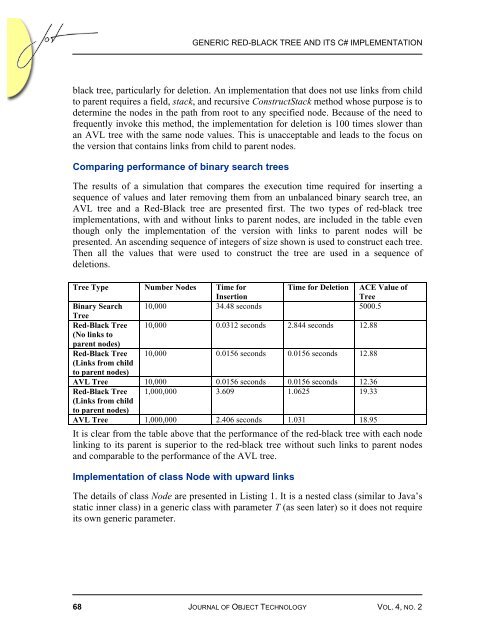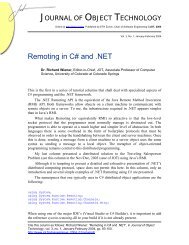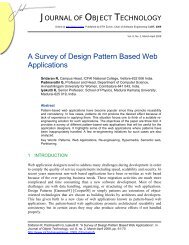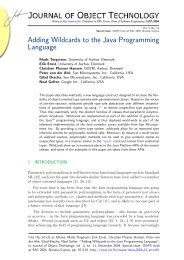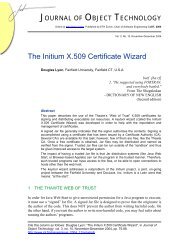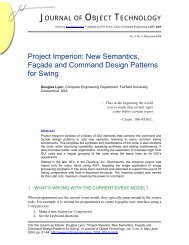Generic Red-Black Tree and its C# Implementation - The Journal of ...
Generic Red-Black Tree and its C# Implementation - The Journal of ...
Generic Red-Black Tree and its C# Implementation - The Journal of ...
Create successful ePaper yourself
Turn your PDF publications into a flip-book with our unique Google optimized e-Paper software.
GENERIC RED-BLACK TREE AND ITS <strong>C#</strong> IMPLEMENTATIONblack tree, particularly for deletion. An implementation that does not use links from childto parent requires a field, stack, <strong>and</strong> recursive ConstructStack method whose purpose is todetermine the nodes in the path from root to any specified node. Because <strong>of</strong> the need t<strong>of</strong>requently invoke this method, the implementation for deletion is 100 times slower thanan AVL tree with the same node values. This is unacceptable <strong>and</strong> leads to the focus onthe version that contains links from child to parent nodes.Comparing performance <strong>of</strong> binary search trees<strong>The</strong> results <strong>of</strong> a simulation that compares the execution time required for inserting asequence <strong>of</strong> values <strong>and</strong> later removing them from an unbalanced binary search tree, anAVL tree <strong>and</strong> a <strong>Red</strong>-<strong>Black</strong> tree are presented first. <strong>The</strong> two types <strong>of</strong> red-black treeimplementations, with <strong>and</strong> without links to parent nodes, are included in the table eventhough only the implementation <strong>of</strong> the version with links to parent nodes will bepresented. An ascending sequence <strong>of</strong> integers <strong>of</strong> size shown is used to construct each tree.<strong>The</strong>n all the values that were used to construct the tree are used in a sequence <strong>of</strong>deletions.<strong>Tree</strong> Type Number Nodes Time forInsertionTime for Deletion ACE Value <strong>of</strong><strong>Tree</strong>Binary Search 10,000 34.48 seconds 5000.5<strong>Tree</strong><strong>Red</strong>-<strong>Black</strong> <strong>Tree</strong> 10,000 0.0312 seconds 2.844 seconds 12.88(No links toparent nodes)<strong>Red</strong>-<strong>Black</strong> <strong>Tree</strong> 10,000 0.0156 seconds 0.0156 seconds 12.88(Links from childto parent nodes)AVL <strong>Tree</strong> 10,000 0.0156 seconds 0.0156 seconds 12.36<strong>Red</strong>-<strong>Black</strong> <strong>Tree</strong> 1,000,000 3.609 1.0625 19.33(Links from childto parent nodes)AVL <strong>Tree</strong> 1,000,000 2.406 seconds 1.031 18.95It is clear from the table above that the performance <strong>of</strong> the red-black tree with each nodelinking to <strong>its</strong> parent is superior to the red-black tree without such links to parent nodes<strong>and</strong> comparable to the performance <strong>of</strong> the AVL tree.<strong>Implementation</strong> <strong>of</strong> class Node with upward links<strong>The</strong> details <strong>of</strong> class Node are presented in Listing 1. It is a nested class (similar to Java’sstatic inner class) in a generic class with parameter T (as seen later) so it does not require<strong>its</strong> own generic parameter.68 JOURNAL OF OBJECT TECHNOLOGY VOL. 4, NO. 2


